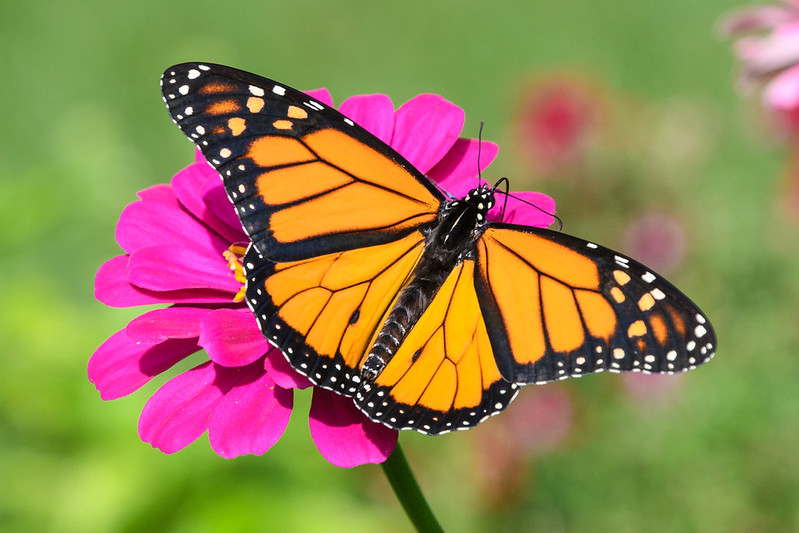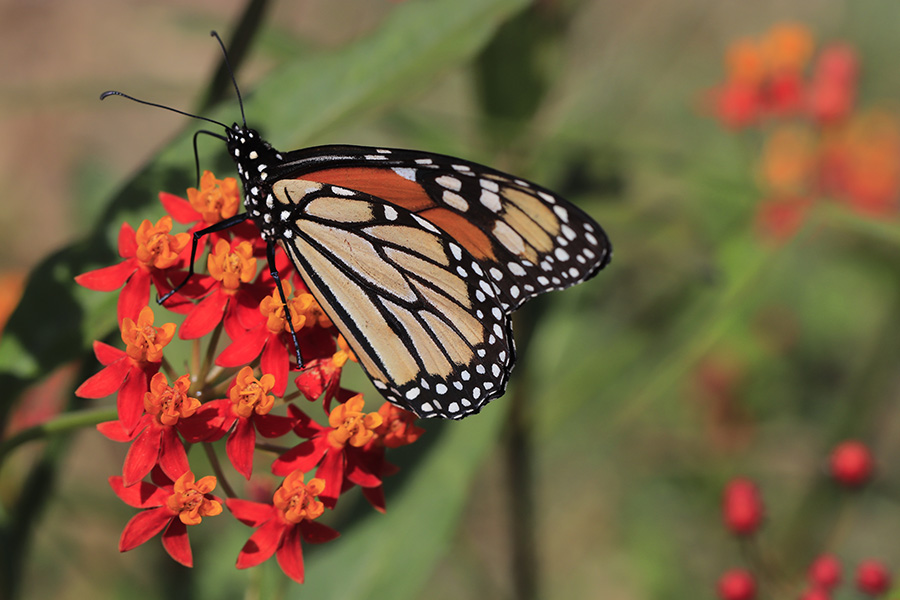Monarch butterflies (Danaus plexippus) are characterized by their resilience and migration. Each year, in a journey that spans four generations, they move from Mexico to Canada. The uniqueness of the length of this journey contributed to the recognition of the butterfly biosphere reserve, northwest of Mexico City, as a World Heritage Site in 2008. However, despite being a species native to the American continent, it is also one of the few insect species capable of making transatlantic crossings. It can also be found in Great Britain, southern Spain, the Canary islands and the north of Africa, where it is strongly associated with the presence of milkweed or Asclepias curassavica. This article, published in the journal El Ágora, warns of the significant decline in their numbers and the efforts being made in North America to alleviate it. These efforts should also be reproduced in the North African and South Mediterranean regions, where this species can be found.
It is one of the most curious and misunderstood adventures in the animal world. The journey that the monarch butterfly, a beautiful little winged thing that weighs half a gram and measures less than a credit card, makes each autumn from one side of North America to the other: from Canada and the northeastern United States to the mountains of central Mexico. A 5,000-kilometer epic. The ultimate road trip.

As the days begin to shorten and the temperatures drop, the monarch butterflies, many of which live, for example, in Central Park, climb into the autumn air currents and head south. On their journey across the central plains of the United States they can cover up to 150 kilometers a day.
Once in Mexico, they swirl by the millions in the branches of sacred oyamel or fir trees, whose foliage protects them from extreme temperatures. The trees are completely covered, carpeted by some 500 million small orange and black fans with white dots. These are their winter quarters, where they rest for a few months. Then the weather warms up. It is time to return. The butterflies take off for Texas and other southern states, where they gorge themselves on the nectar of the asclepias, mate and deposit their shiny eggs in the flowers.
Then, they continue their heroic route northward and mate in other places rich in this type of fleshy flower, also known as milkweed. From here, however, their track begins to blur. Scientists estimate that it takes four or five generations, each living between five and seven weeks, for the butterflies to return to their original northern regions.
And here comes the interesting thing, in addition to being the only migratory butterfly: on the journey north, the butterflies die off and are replaced by their offspring, several times. But then, the generation that undertakes the 5,000 kilometers pilgrimage to Mexico during the winter is much longer-lived. They can live up to eight months: five or six times longer than their descendants.
According to the reconstruction made by National Geographic, monarch butterfly observers still do not know exactly why this difference occurs. One hypothesis is that, during the long flight to Mexico, these millions of butterflies avoid a parasite called EO, which accumulates in late summer. This would allow them to live long enough to complete the journey.
On the journey north, the butterflies die off and are replaced by their offspring, several times. But then, the generation that undertakes the 5,000 kilometers pilgrimage to Mexico during the winter is much longer-lived.
The number of monarch butterflies at risk
But scientists are worried about the clear decline in the number of monarch butterflies. The Mexican government has said that the number of specimens overwintering in the country fell by 26% between 2019 and 2020. If we go back even further in time, the contrast is radical: in 2018 monarch butterflies, which covered six hectares of forest in central Mexico, represented barely a third of those that could be counted in 1990.

The reasons, as experts explain, are complex, but the fundamental one seems to be the following: the plants on which monarch butterflies feed are increasingly scarce. And this prevents them from accumulating the necessary fat to endure the journey. As a result, more butterflies than ever are falling during the journey.
Many of the perennial plants on which these insects live are not very appreciated by humans, especially farmers. The journey of the monarch butterflies passes through agricultural states such as Iowa, Kansas and Oklahoma, where the hand of man prepares the land for farming or having livestock. When the butterflies stop to refuel, they often do not find enough food.
The reasons, as the experts explain, are complex, but the fundamental one seems to be the following: the plants on which the monarch butterflies feed are becoming increasingly scarce.
Global warming, of course, may have something to do with it. Last February, Texas was the victim of an arctic cold snap that paralyzed part of its infrastructure and left more than 200 people dead. The blanket of frigid air may have killed part of the vegetation on which these butterflies rely. The intensity of summer heat and drought in the southeastern U.S. have also made movement difficult.
The Tribal Environmental Action for Monarchs’ Initiative
Monarch lovers have taken note and want to curb this trend. One of the most original initiatives is led by Jane Breckinridge, a citizen of the Muscogee Nation, a Native American tribe that established in Oklahoma more than a century ago.
Jane Beckinridge, whose husband owns a butterfly farm, tells journalist Nick Martin in The New Republic that she became interested in butterfly conservation about a decade ago. The couple moved to Oklahoma, where she had spent her childhood, and ended up starting their own butterfly farm. Gradually, Beckinridge launch a raising awareness effort on the monarch butterfly, mostly focused on schools. On one occasion, he invited one of the foremost experts in the field, Chip Taylor, an insectologist and author of the Monarch Watch blog, to speak.

Over time, Taylor and Beckinridge became more involved in the knowledge and protection of this species, and eventually founded TEAM (Tribal Environmental Action for Monarchs). Their goal, given Beckinridge’s background and the connection of some indigenous tribes to nature, was to form a large Native American coalition dedicated to the breeding, care and conservation of these butterflies. For example, getting the seeds of the right plants, or building greenhouses and tunnels for breeding, or spreading the word about the importance of protecting this species, key in the pollination process.
They only needed two things: contacts and help from the federal government. The former was solved with 50,000 car miles in three years. Beckinridge himself traveled all over the state, talking to all the tribal chiefs and, in the process, studying the conditions on the ground for the butterflies’ well-being. From the window he observed vast expanses of hostile landscapes, flattened by heavy herbicide use or filled with foreign and unsuitable plants.
“Every time we were out there, meeting with tribal leadership, if you said, ‘the monarchs are in trouble, their numbers are plummeting,’ they’d say, ‘OK, what do we have to do?” recalls Beckinridge. “It was never ‘why?'”
“Every time we were out there, meeting with tribal leadership, if you said, ‘the monarchs are in trouble, their numbers are plummeting,’ they’d say, ‘OK, what do we have to do?” recalls Beckinridge. “It was never ‘why?'”
The second challenge, federal money, also eventually came. According to the article, Beckinridge won Chip Taylor’s admiration by writing slick requests for grants and scholarships from government environmental protection agencies. In 2015 they landed a quarter of a million dollars.

Since then, TEAM says it has planted some 50,000 milkweed and 30,000 wildflowers so monarch butterflies can stop to refuel in the midst of their long, demanding journeys. In addition, Beckinridge has created a seed bank on his farm for the future.
Another hopeful sign is the proliferation of milkweed in large cities acts as an attraction field for pollinators. In 2019, a study estimated that the cultivation of this plant could make urban agglomerations like New York a sanctuary for lepidopterans.
The case of the monarch butterflies is reminiscent of that of migratory birds in the US, which in the summer of 2020, during the worst fire season ever recorded, began falling from the sky as if it was a chapter from the Bible. The reason was not entirely clear. According to a biologist’s statements to The Guardian, they collapsed from exhaustion. The fires had devoured or affected part of the ecosystems where the birds stop to eat and replenish their energy.
These butterflies are not exclusive to North America. North Africa and New Zealand also have their swarms, but they are not traveling swarms. Those exist only in the superb territories of the United States and Mexico. Millions of colorful fans, smaller than an ID card, to which the slap of the weather and herbicides threaten to spoil their road trip.
Source: El Ágora
This post is available in: English Español

